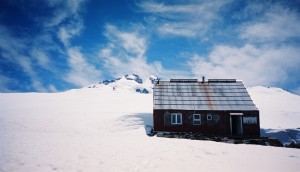August 9, 2006
The trick to stopping a backward slide, my guide explains, is to face downwards and dig your feet and fingers into the snow while keeping your butt in the air (like a downward dog in yoga). Lying on your stomach, as novices tend to do, will simply increase the speed of your descent. This instruction leaves me — as I mentally calculate the distance to the precipice behind us at about 15-20 metres — with one obvious question: how long does it take to come to a full stop with this braking maneuver?
Â
I was hiking up El Tronador (The Thunderer, for its falling glacier fragments), with the objective of spending a night at the Otto Meiling Refuge, three quarters of the way to the top of this Andean beauty in the Patagonia Lakes District of Argentina. El Tronador (3478m) is on the border with Chile and 80 kilometres from the tourist hub of Bariloche.Â
Â
The initial part of the 18-kilometre ascent followed an easy forest trail with the day’s temperature pleasant enough to be content in a t-shirt. This was in line with my goal: a bit of tranquility after a week in bustling Buenos Aires — a 20-hour bus ride to the northeast. In answer to my question about how much snow I could expect on the mountain, an advisor at the Club Andino in Bariloche held his thumb and forefinger modestly apart.  When I emerged from the forest and contemplated the heavily snow-covered slope, I recalled his description. Â
Â
I was at least content that the park rangers had obliged me to hire a guide for the upper part of the trek. A rendez-vous point and price ($36 CDN) was arranged by walkie-talkie with a guide, Mauricio, who is stationed at the refuge. We used snowshoes for about a kilometre before reaching an intimidating incline, which resembled the spine of a massive snow-covered dinosaur. At the upper end — our objective — was the top of its flat head, the sides that descended from the crest of its spine looked like the round ribs of the creature, while the lower end had a tapered tail, beyond which there was a drop that didn’t hit land again until it really wouldn’t matter anyway.
Â
I had no difficulty imagining myself sliding down the back of the dinosaur, bum in the air, gnarled fingers frantically digging into the snow and then — with a pathetic look on my face suggesting this holiday would end sooner than planned — being launched with a swoosh off the mountain into the sweet here-after.
Â
Motivated by these images I kept my head down and followed the guide step for step, carefully securing each foothold. I didn’t look up again until we were standing safely on the dinosaur’s head.
Â
Nearby, behind a small rock outcropping the bodies of two unfortunate climbers — brothers — had been found just two weeks earlier. They had apparently ignored warnings about bad weather. My guide figured that one of the brothers had been injured and they huddled behind the rocks before succumbing to the dropping temperature. Searchers had expected to find their bodies closer to the summit — another 1500 metres higher — instead of here, an easy 30-minutes to the refuge. Â
Â
The Meiling refuge, named after a German-born mountaineer famous in the area, is nestled behind a gentle slope with a glacier on each side. It has a kitchen and dining area on the main floor and a sleeping area above. Â
Later, as I sat looking out over the green expanse far below, the summit looming behind me, I felt the mountain’s raw power. I’ve heard people talk about conquering a mountain; I felt that this mountain, perhaps any big mountain, simply tolerates its visitors: allows them to appreciate its majesty, marvel at its height, and wonder at its beauty. It is perhaps to remind us that we are not its masters that the mountain suddenly, unexpectedly takes victims: snuffs them out in avalanches, sends them over giant precipices, or simply confuses and blinds them in a stormy embrace.
Â
I savoured the sights and sounds: watched the clouds roll across the summit, basked in the sun’s warmth, and listened to the singing of tiny birds. Then, at night, I pulled my sleeping bag tightly around me as the wind pummeled the humble refuge and rattled its windows.
Â
The next day, with ominous clouds threatening rain, I left early to avoid dealing with snow made slick by rain. The descent was easier; even the dangerous slope seemed less severe. When I reached the edge of the retreating snow line I felt safe again yet already sorry to be letting the beauty of El Tronador slip away.
